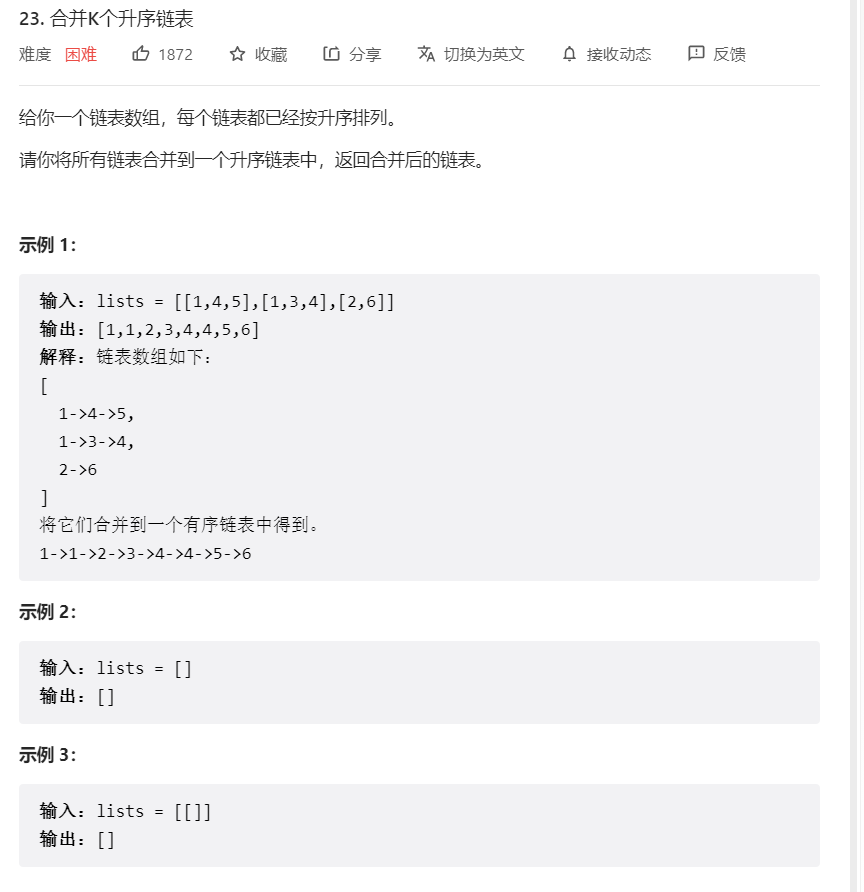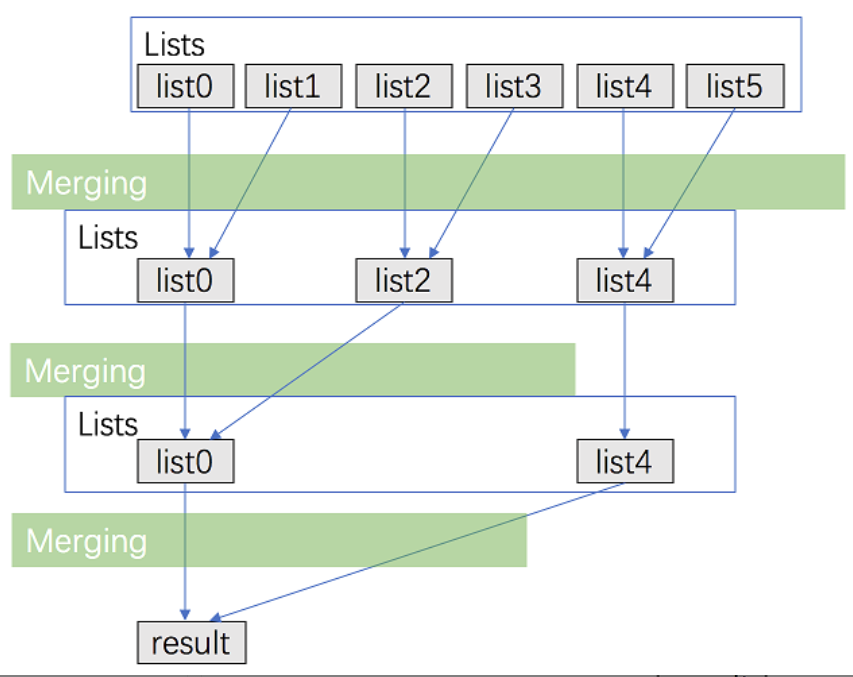一、题目

二、思路
这里需要用到前边所学的合并两个升序链表,函数如下:
public ListNode mergeTwoLists(ListNode a, ListNode b) {
if (a == null || b == null) {
return a != null ? a : b;
}
ListNode head = new ListNode(0);
ListNode tail = head, aPtr = a, bPtr = b;
while (aPtr != null && bPtr != null) {
if (aPtr.val < bPtr.val) {
tail.next = aPtr;
aPtr = aPtr.next;
} else {
tail.next = bPtr;
bPtr = bPtr.next;
}
tail = tail.next;
}
tail.next = (aPtr != null ? aPtr : bPtr);
return head.next;
}
2.1、依次相加排列
用一个变量 ans 来维护以及合并的链表,第 i次循环把第 i 个链表和 ans 合并,答案保存到 ans 中。
class Solution {
//依次合并两个链表
public ListNode mergeKLists(ListNode[] lists) {
ListNode ans = null;
for(int i = 0; i<lists.length; i++){
ans = mergeTwoLists(ans,lists[i]);
}
return ans;
}
//合并两个链表
public ListNode mergeTwoLists(ListNode a, ListNode b) {
if (a == null || b == null) {
return a != null ? a : b;
}
ListNode head = new ListNode(0);
ListNode tail = head, aPtr = a, bPtr = b;
while (aPtr != null && bPtr != null) {
if (aPtr.val < bPtr.val) {
tail.next = aPtr;
aPtr = aPtr.next;
} else {
tail.next = bPtr;
bPtr = bPtr.next;
}
tail = tail.next;
}
tail.next = (aPtr != null ? aPtr : bPtr);
return head.next;
}
}
2.2、分治合并
将 k 个链表配对并将同一对中的链表合并;第一轮合并以后, k个链表被合并成了 k/2
个链表,平均长度为 nk/2 ,然后是k/4个链表, k/8个链表等等;重复这一过程,直到我们得到了最终的有序链表。

class Solution {
public ListNode mergeKLists(ListNode[] lists) {
return merge(lists, 0, lists.length - 1);
}
public ListNode merge(ListNode[] lists, int l, int r) {
if (l == r) {
return lists[l];
}
if (l > r) {
return null;
}
int mid = (l + r) >> 1;
return mergeTwoLists(merge(lists, l, mid), merge(lists, mid + 1, r));
}
public ListNode mergeTwoLists(ListNode a, ListNode b) {
if (a == null || b == null) {
return a != null ? a : b;
}
ListNode head = new ListNode(0);
ListNode tail = head, aPtr = a, bPtr = b;
while (aPtr != null && bPtr != null) {
if (aPtr.val < bPtr.val) {
tail.next = aPtr;
aPtr = aPtr.next;
} else {
tail.next = bPtr;
bPtr = bPtr.next;
}
tail = tail.next;
}
tail.next = (aPtr != null ? aPtr : bPtr);
return head.next;
}
}
2.2、使用优先队列合并
这个方法和前两种方法的思路有所不同,我们需要维护当前每个链表没有被合并的元素的最前面一个,k 个链表就最多有 k 个满足这样条件的元素,每次在这些元素里面选取 val 属性最小的元素合并到答案中。在选取最小元素的时候,我们可以用优先队列来优化这个过程。
class Solution {
class Status implements Comparable<Status> {
int val;
ListNode ptr;
Status(int val, ListNode ptr) {
this.val = val;
this.ptr = ptr;
}
public int compareTo(Status status2) {
return this.val - status2.val;
}
}
PriorityQueue<Status> queue = new PriorityQueue<Status>();
public ListNode mergeKLists(ListNode[] lists) {
for (ListNode node: lists) {
if (node != null) {
queue.offer(new Status(node.val, node));
}
}
ListNode head = new ListNode(0);
ListNode tail = head;
while (!queue.isEmpty()) {
Status f = queue.poll();
tail.next = f.ptr;
tail = tail.next;
if (f.ptr.next != null) {
queue.offer(new Status(f.ptr.next.val, f.ptr.next));
}
}
return head.next;
}
}
三、对比分析
最后
以上就是健壮香烟最近收集整理的关于23、合并k个排序链表的全部内容,更多相关23、合并k个排序链表内容请搜索靠谱客的其他文章。
本图文内容来源于网友提供,作为学习参考使用,或来自网络收集整理,版权属于原作者所有。









发表评论 取消回复